Menu
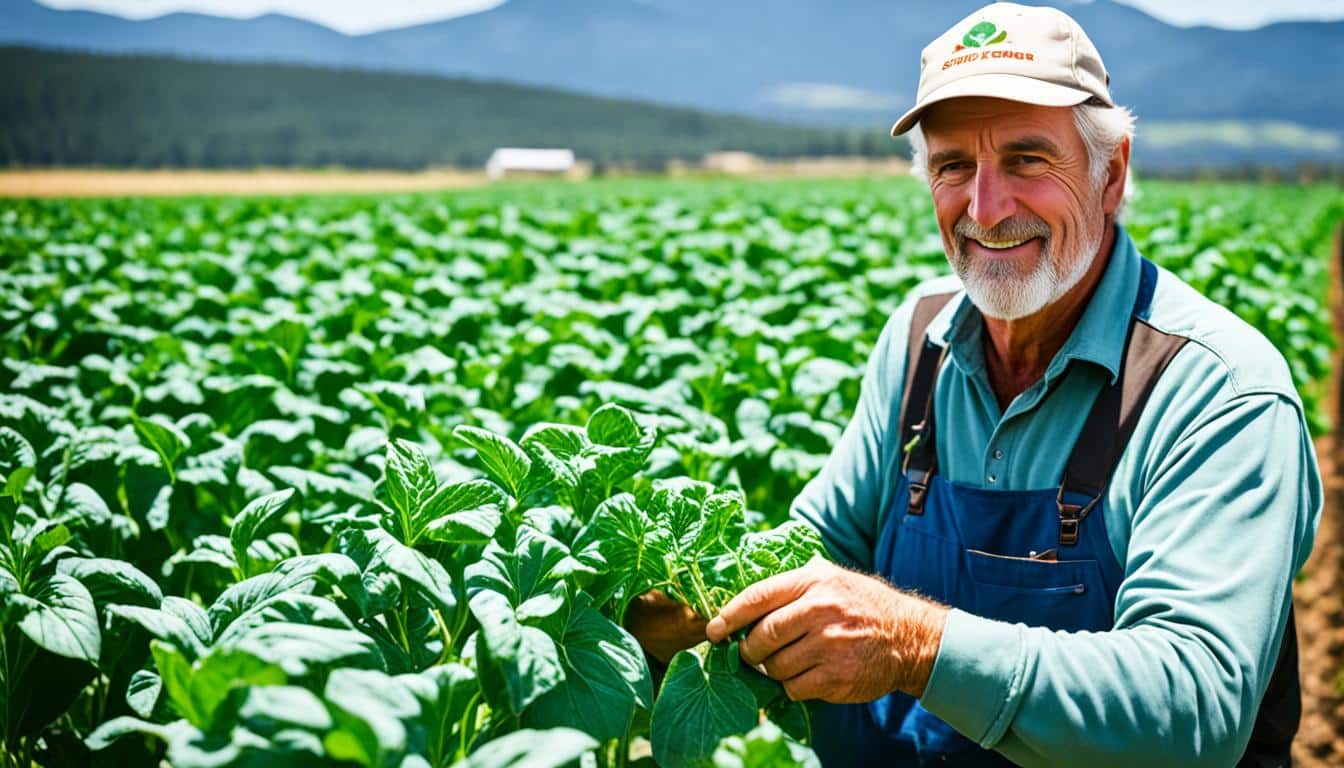
Did you know the U.S. farm sector employs 2.6 million people? It creates nearly $400 billion in goods each year. This industry has seen a big growth in its output over the past 20 years. Yet, agriculture is behind 10% of U.S. emissions and 25% of the world’s greenhouse gases.
The world’s appetite for food will jump 56% by 2050. This poses a big challenge for farmers. They need to grow more food but with less harm to the environment. To fight climate change, they aim to cut emissions by two-thirds before 2050. This means using sustainable ways to farm is a must. It will help the earth and the future of farming.
It’s key to cut down on agricultural emissions to fight climate change. With global food demand set to soar by 56% from 2010 to 2050, the stakes are high. Agriculture makes up about 10% of U.S. emissions and a quarter of global greenhouse gases.
This shows why it’s urgent to tackle these emissions. The world is working hard to avoid severe climate effects.
In 2007, the U.S. farm sector emitted a lot of methane through livestock, manure, and rice. Over 40% of these emissions came from livestock alone. Crop production also plays a big part, mostly because of the use of synthetic fertilizers.
Although agriculture has increased productivity by 30% between 1997 and 2017, its emissions grew by just 7%. This small rise in emissions with increased productivity shows the sector has a big opportunity to adopt more eco-friendly ways.
| Emission Source | Contribution to Total Agricultural GHGs (%) |
|---|---|
| Enteric Fermentation | 25% |
| Manure Management | 15% |
| Rice Cultivation | 5% |
| Synthetic Fertiliser Use | 50% |
| Total Emissions | 100% |
The agricultural sector needs to do more. It must improve productivity while reducing its greenhouse gas emissions. This requires new ideas and policies like changing what livestock eat, using manure digesters, and farming in ways that save energy.
Encouraging carbon sequestration activities, such as conservation tillage and growing cover crops, is also important. Furthermore, it’s crucial to offer direct rewards for efforts to reduce emissions. Policy measures, like the Renewable Fuel Standard, help push for more renewable energy. This all fits into a wider eco-friendly farming plan.
Overall, the aim is to keep productivity strong but in ways that are better for the environment. This is crucial for agricultural greenhouse gas reduction in the coming years.
Using sustainable farming practices is crucial for cutting down on greenhouse gas (GHG) emissions. Methods such as conservation tillage, crop rotation, and cover cropping make a big difference. They not only lock away carbon but also boost soil health and support good land management.
Conservation tillage is at the heart of managing land sustainably. It cuts down on turning the soil. This keeps the soil’s structure strong, making it better at storing carbon. Conservation tillage also lowers CO2e emissions, helps with water retention, and fights erosion. This means farm systems are more able to bounce back from challenges.
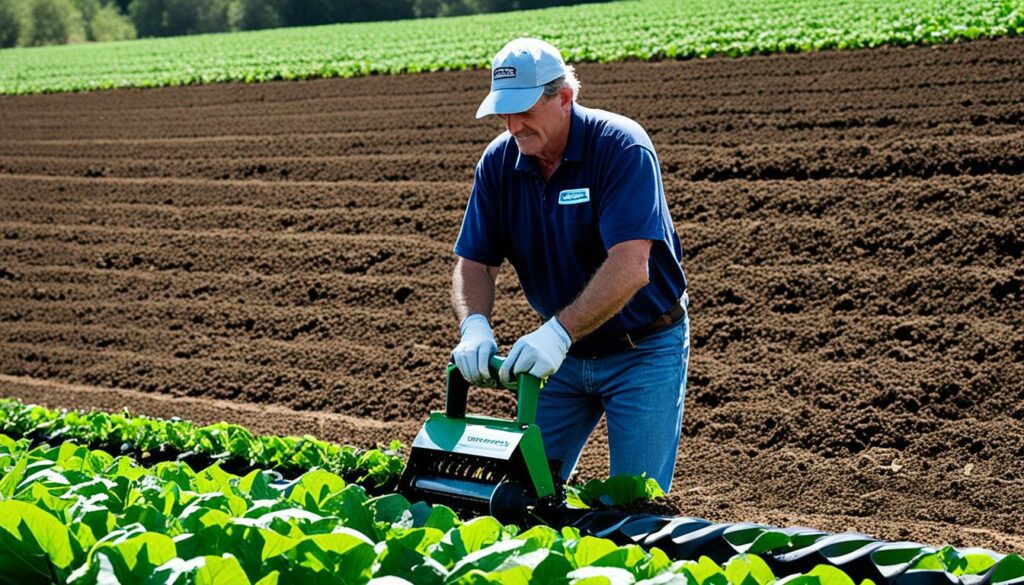
Rotate crops and grow cover crops are key for managing land well. This process encourages different crops and plants between growing seasons. It keeps soil nutrients high and disrupts pest life cycles. This lowers the need for chemicals.
Using cover crops also helps cut emissions by keeping the soil healthy. It holds water better and welcomes small insects and organisms. These methods are vital for keeping agriculture cleaner and more earth-friendly.
New technologies in agriculture help cut down on the gases hurting our environment. Things like precision farming, automatic tools, and eco-friendly ways to protect crops lead the way. They’re key to making farming better for the planet.
Precision farming uses data to farm smarter. With GPS and sensors, farmers make sure every seed and drop of water goes where it’s needed. This not only boosts crop growth but also lessens the farm’s impact on the environment.
Self-driving tractors and drones are changing farming. They do their job precisely, saving fuel and money. Without needing human hands, they work tirelessly, making farming more efficient with fewer emissions.
Using nature to fight pests means fewer harmful chemicals on crops. Good bugs, fungi, and bacteria help keep fields healthy, which is good for the Earth. It also keeps crop production high without adding pollution.
These new techs are set to make a big dent in the emissions from farming. They could even take over 13 billion tons of carbon out of the air each year. This could be a game-changer in our fight against climate change.
| Innovation | Impact on Emissions |
|---|---|
| Precision Agriculture | Reduces waste, optimises resource use |
| Automated Farming Machinery | Increases efficiency, reduces fuel consumption |
| Biological Crop Protection | Minimises reliance on chemical pesticides |
| Argonne’s GREET Model Simulation | Potential 70% reduction in GHG emissions from grain production |
Livestock farming significantly adds to greenhouse gases through animal digestion and manure breakdown. Key steps in cutting methane involve changing what animals eat and managing manure.
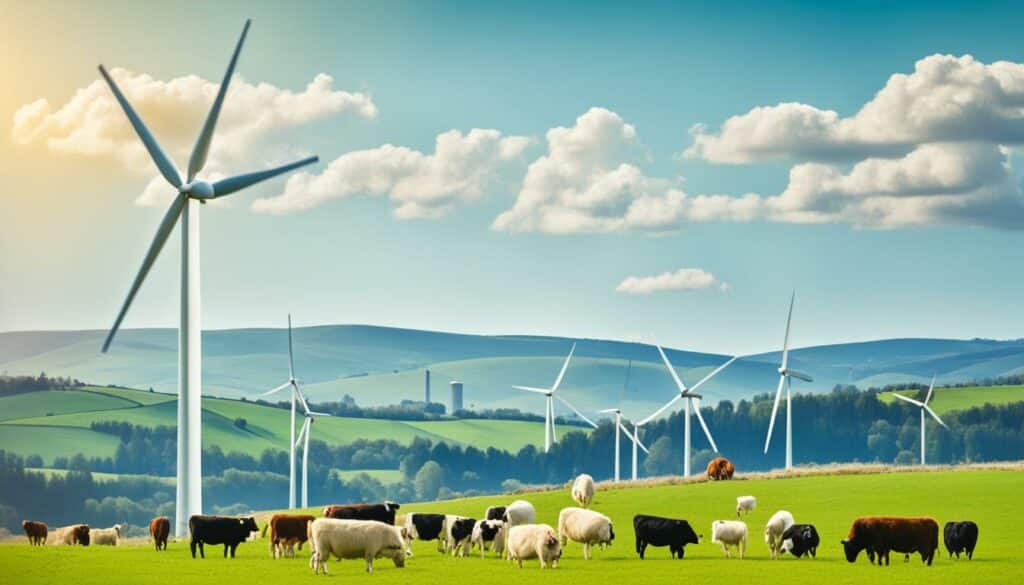
Changing what animals eat can greatly reduce methane. Adding certain things to their food decreases methane in their bodies. Also, dealing with manure in a specific way can both lower emissions and produce energy from methane.
Choosing animals that naturally make less methane is vital too. By selectively breeding these animals, we can sharply lower our methane footprint. This also improves the animals’ well-being, while cutting down on greenhouse gases.
Using new tech and farming methods can make operations more efficient and eco-friendly. For example, applying fertiliser more precisely cuts down GHG from fossil fuels. This kind of smart farming reduces methane from nitrogen fertilisers.
Encouraging greener farming through policy is another helpful step. Measures like cap-and-trade markets and standards for renewable fuels offer benefits for adopting clean practices. They help farmers earn while working towards reducing emissions.
Climate-Smart Agriculture (CSA) is a key way to fight climate change and improve farm output. It combines eco-friendly farming with making money. This helps farms be both strong and friendly to the planet.
Climate-smart agriculture aims to do three main things: boost how much food we grow, make farms tough against bad weather, and cut down on harmful gases. Since farming globally gives off 1/3 of the world’s gases and causes most of deforestation, CSA is a big deal.
Big steps are being taken, like the World Bank increasing its CSA support eightfold, to nearly $3 billion a year. Also, countries like Bangladesh, Belize, and Burkina Faso have special plans for CSA.
There are many money wins from sustainable farming with CSA. For example, China got a $345 million loan to make its farming more eco-friendly. And, Eastern and Southern Africa alone have a $621 million programme to help their farms stay strong against climate change. These steps help farmers make more money and spend less in the long run.
Pakistan and Jordan also got big funds to make their farms tougher. Pakistan got $200 million for farming projects, and Jordan got $125 million to help its farmers beat climate challenges.
“Executive Order 14008, signed on January 27, 2021, underscores the necessity of a coordinated approach across all Federal agencies to combat the climate crisis effectively.”
In summary, by supporting climate-smart agriculture, we not just help farms be eco-friendly. We also help them make more money. This makes CSA important as we aim for a stronger farm future.
Good crop management is key for cutting greenhouse gas emissions in farming. Using new methods, farmers can lower their environmental impact. This means they use different ways to grow their crops that are better for the planet.
To cut down on nitrous oxide, farmers must manage their fertilisers well. They can use special inhibitors, slow-release types, and be more precise in spreading them. This helps match how much the plants need with what they get. As a result, less gets released into the air.
Going organic is great for wildlife and the earth’s health. Organic farming says no to man-made pesticides and fertilisers. Instead, it uses natural stuff that makes the ground strong and fertile. This leads to more organic matter in the soil, which traps carbon, helping the planet.
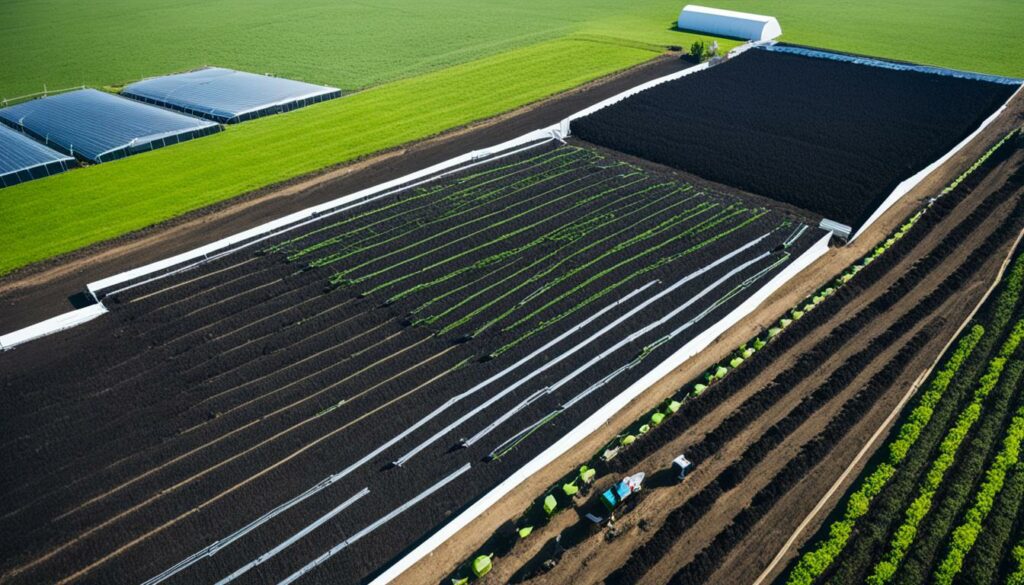
Reusing leftovers from farming can help meet green goals. Last year’s plant leftovers are full of what new crops need and help the soil stay healthy. By mulching or composting these leftovers, farms can recycle these nutrients. This cuts the need for chemicals and waste.
| Practice | GHG Emission Reduction | Additional Benefits |
|---|---|---|
| Fertiliser Management | Lower nitrous oxide emissions | Improved nutrient use efficiency |
| Organic Farming | Enhanced carbon sequestration | Increased biodiversity |
| Agricultural Residue Utilisation | Reduced synthetic fertiliser need | Improved soil health |
By using smart fertiliser plans, turning to organic methods, and recycling farm leftovers, big emissions cuts are possible. Besides helping the environment, these changes make farms stronger and more productive.
In the fight against agricultural emissions, using carbon sequestration practices is key. In the last 12,000 years, the soil has released about 133 billion metric tons of CO2. This is more than what human activities emitted in 2019. Due to this, up to 70 percent of organic carbon in cultivated soils is lost. This shows the urgent need for *soil carbon storage*.
The global potential to cut about 5.3 GtCO2 per year by 2030 through soil carbon sequestration is huge. Between 2000 and 2010, agriculture produced 5.0–5.8 GtCO2-equivalents each year. The IPCC says doing this using new technologies would cost US$100 per ton of CO2. And, this approach could reduce up to 3.8 GtCO2 per year.
There are many ways to boost carbon sink enhancement in farm soils. Methods like agroforestry and silvopasture add trees and shrubs to farms to store more carbon. The USDA is also making its Conservation Reserve Program better. It now offers more incentives, higher payments, and climate-friendly practices. This aims to promote carbon sequestration practices by using perennial crops, cover cropping, and planting more trees (afforestation).
| Year | CO2 Released (GtCO2) |
|---|---|
| 2000-2010 | 5.0–5.8 GtCO2-equivalents/year |
| By 2030 | 5.3 GtCO2/year (potential mitigation) |
Even with good options to increase carbon sinks, almost 40 percent of U.S. farmland is rented. This makes it hard to widely use regenerative farming practices. But, legislative help such as the Growing Climate Solutions Act is stepping in. It looks to make it easier for farmers to join voluntary carbon markets. This support encourages the broader use of carbon sequestration technologies.
Government policies and initiatives play a key role in steering the farming sector. They aim to lower greenhouse gas (GHG) emissions. These steps are vital in making farming less damaging to the environment.
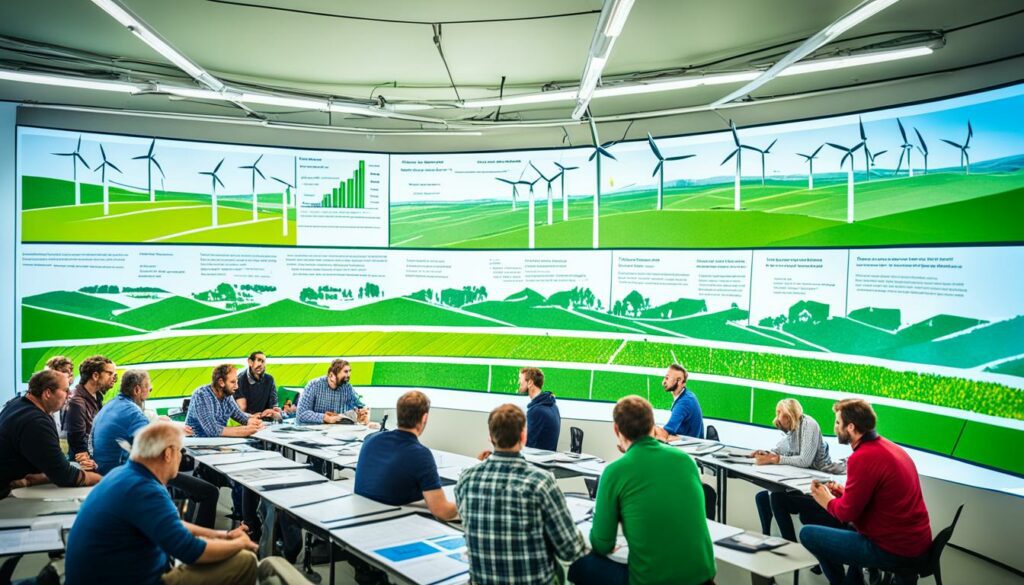
The U.S. government has started to see the potential of farming in cutting GHG emissions. The Environmental Protection Agency (EPA) found in 2021 that farming made up 10.6 percent of the USA’s GHG emissions. This equals 671.5 million metric tons of carbon dioxide.
Nearly half of these emissions were nitrous oxide, while over 40 percent was methane. With the remaining 11.9 percent coming from carbon dioxide. With these high numbers in mind, it’s clear that we need laws that help control the emissions from farms.
The U.S. Department of Agriculture (USDA) is working hard to slash emissions. They put over $1 billion into projects promoting climate-smart farming. This investment has now more than tripled to over $3 billion thanks to its success. These projects should stop over 50 million metric tons of carbon dioxide from going into the air. They will involve more than 50 thousand farms over 20-25 million acres.
The next steps in cutting GHGs from farms involve more policy input and new laws. Recommendations include making current programs better and starting new ones. These would encourage farmers to use climate-friendly methods.
Creating new markets for farm goods made in eco-friendly ways is also crucial. It helps encourage more green practices. For example, a task force has formed to push using methane for clean energy on farms. These efforts highlight the need for clear and far-reaching climate laws. Taking these proactive steps is critical for a healthy and sustainable farming future.
In farming, using renewable energy is crucial. It helps cut down on greenhouse gases. By using solar power, producing bioenergy, and using wind power, farms move to more sustainable methods.
Putting up solar panels and wind turbines on farms has many good points. Solar power in farming lets us use the sun to make energy. This way, we use less fossil fuel, which drops CO2 from our machines and vehicles.
Wind power is also key. By catching the wind, farmers can make their electricity. This makes them less reliant on energy from outside sources.
Studies are showing more and more interest in these technologies. Around 75% of new research looks at using solar panels on farms. About 30% focuses on how mixing solar and agriculture can improve farming and its sustainability.
Bioenergy also helps lower emissions on farms. It uses waste and leftovers to make biogas through a process called anaerobic digestion. This biogas can then be used for heating and making power. This way, we cut down on waste and methane from farming.
Farmers can also grow special plants for making biofuels. This fits with policies encouraging making fuel from plants.
Using these renewable energy sources makes farms more independent for energy. It also helps make a future with less carbon and energy waste. Around 20% of new studies look at how green farming can save money and lead to sustainable growth.
Looking at case studies on emissions reduction helps us understand how to fight climate change. Different places are using new methods that are good for the planet. For example, over 100 countries have agricultural goals to reduce pollution.
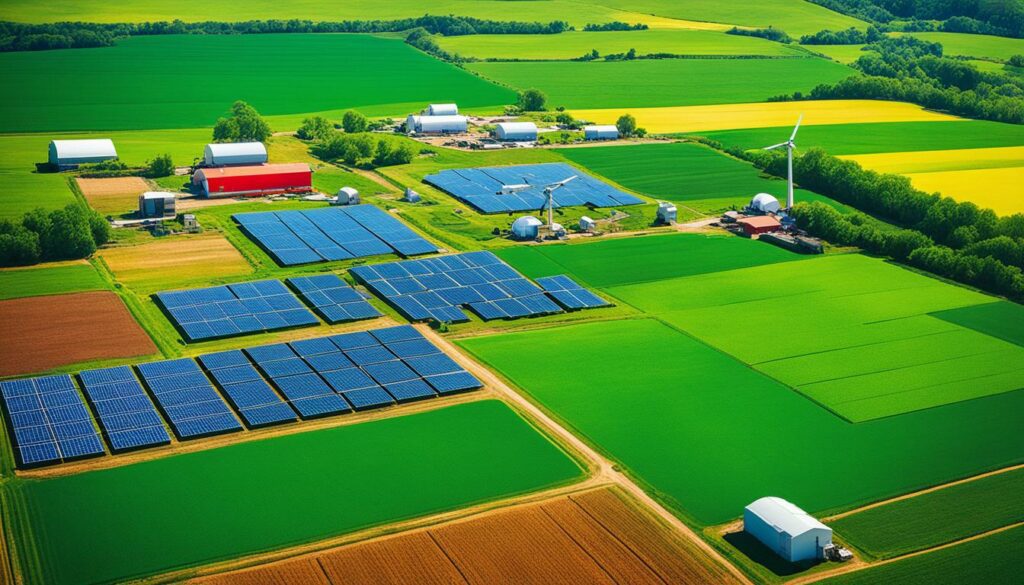
Studies show good results in US projects focusing on rice, trees, and animals. Using the Alternate Wetting and Drying (AWD) method in growing rice can cut methane by half. It also saves 30% more water compared to always keeping fields flooded.
In Bangladesh, using the Urea Deep Placement (UDP) method on rice fields cut nitrous oxide. Adding trees and long-term crop areas has also shown to store carbon and reduce pollution from fertilisers.
In Kenya, cutting down the size of animal herds by 10% has worked well. This is done by helping animals grow fast and having better ways to sell them. In Ethiopia, making grasslands better is helping store more carbon and improve the quality of the land, thanks to protecting natural areas.
These case studies on emissions reduction show how important it is to use smart agricultural ways. We need to work together, supported by big efforts and research. This shows we can really make the planet better and agriculture more sustainable.
Sustainable land management is vital for a greener future. It provides ways to look after and better the land. This includes reducing land conversion and using agroforestry. These strategies help the agriculture world lower carbon emissions. And they create a sustainable environment for the future.
Lessening land conversion is key in sustainable land management. By 2030, agriculture and forestry could cut 135 MMT CO2 a year. This is done by stopping forest conversion, cutting emissions from making fertilisers, and using energy better on farms. These actions help agriculture make a big cut in CO2 emissions. They improve efforts to keep the land sustainable.
Using agroforestry is a strong move for sustainable land management. Agroforestry mixes trees and shrubs into farming areas. This can boost carbon storage in forests by 32% by 2030. It means taking out 330 MMT CO2 extra through reforestation and better forest management. This method sequesters carbon. It also makes the land healthier, increases biodiversity, and supports sustainable agriculture.
| Strategy | CO2 Reduction Potential by 2030 |
|---|---|
| Halting Forest Conversion | 135 MMT CO2 |
| Reducing Emissions from Fertiliser Manufacturing | 135 MMT CO2 |
| Improving Energy Efficiency on Farms | 135 MMT CO2 |
| Reforestation and Improved Forest Management | 330 MMT CO2 |
The agricultural sector is a big player in climate change, mostly because of its greenhouse gas (GHG) emissions. In 2021, it was responsible for around 10.6 percent of U.S. GHG emissions. This included things like 671.5 million metric tons of carbon dioxide equivalent. These emissions come from activities like using fertilisers, changing land areas, and managing animals. They contribute to the Earth getting warmer by about 1.0°C (1.8°F) over 115 years.
Fertiliser use, changes in land use, and how animals are managed play a big role in these emissions. For example, using fertilisers leads to a lot of nitrous oxide being released. Methane comes mainly from how we keep animals and handle their waste. When we change the way we use the land, like cutting down trees or disturbing the soil, it also adds to the emissions. To lower the effects of agriculture on climate change, we need to focus on these areas.
To cut down on agriculture’s impact, we need a solid plan. This plan should use better farming methods, new technology, and strong government support. For example, we could be smarter about how we use fertilisers to reduce nitrous oxide. Or, we could come up with new ways to feed and look after animals to produce less methane. Also, the government can encourage using sustainable farming methods and new tech. These changes can help agricultural lands store more carbon, making them a vital part of fighting climate change.
To learn more about how farming can reduce its GHG emissions, look at trusted sources like the USDA Economic Research Service.
Agricultural greenhouse gas emissions make up about 10% of U.S. emissions. They account for around a quarter of global emissions. These come from using fertiliser, managing livestock, and changing how we use land.
By 2050, global food demand is set to increase by 56%. This higher demand could lead to even more emissions. But, if we use new farming approaches and technology, we could cut these emissions down.
Conservation tillage doesn’t disturb the soil much. This keeps carbon in the ground and reduces emissions. It also makes the soil healthier, cuts down erosion, and helps the soil hold more water.
Changing the crops we grow and adding cover crops is good for the soil. These methods stop soil from being washed away, help the soil hold water better, and make the soil richer. This means we need less chemical fertilisers and lowers emissions.
Precision farming uses data to farm smarter. It cuts down on using too much fuel and lowers emissions. This way, we use our resources better, and we produce more food.
Automated machines make farming more efficient and use less fuel. By using the latest tech, farmers can grow more with fewer emissions. This is good for lowering the gases that harm our planet.
Using natural ways to keep pests away means we don’t need as many chemicals. This cuts down on harmful gases and helps the planet. It’s a win for both the environment and farming.
We can lower methane by feeding animals differently, choosing the right animals to breed, and managing their waste carefully. These changes also make the animals healthier. Plus, they help us fight climate change by cutting down on gases.
CSA farming is good for the environment and the economy. It aims to use new methods to grow food, making farms stronger against bad weather, needing less water, and still making money.
Using fertilisers wisely can help lower emissions. Methods like using special fertilisers and putting them where they are needed mean we waste less and harm the atmosphere less. Our soils stay healthy too.
Organic farming makes the soil and nature stronger without using harmful chemicals. This cuts down harmful gases and keeps the air clean. It’s all about caring for the earth in a natural way.
By using leftover crop parts to make the soil better and feed the next plants, we can stop using some chemicals. This is good for the earth and for our efforts to lower harmful gases.
Carbon sequestration is about capturing CO2 in the ground and in plants. We can do this by planting trees with crops, using fields in smart ways, and growing crops that cover the ground. These methods are great for lessening the CO2 in the air.
Laws in the U.S. are pushing for greener farming. They offer rewards for doing things that help the climate, support new tech, and aim to produce more food with less gas waste. These rules are here to protect our natural spaces too.
Solar, wind, and energy from plants can power our farms without adding to the greenhouse effect. By using these clean sources, farmers help make our energy cleaner while continuing to make food in a way that’s safe for the planet.
Studies show that smart farming can greatly cut down bad gases. They report big drops in methane and nitrous oxide, more captured carbon, and the use of methods that keep working with nature. These lessons are key for planning the future of farming.
By avoiding changing natural land and by growing crops alongside trees, we protect the land and lower CO2 in the air. These ways keep the land healthy and help our planet by keeping carbon where it belongs.
Using too much fertiliser, changing how we use land, and handling livestock make up a big part of the gas problem. We need better ways to farm that use less of these harmful gases and keep the air clean.